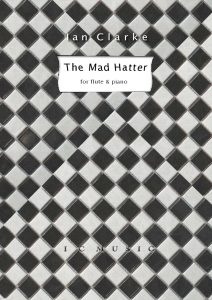The Mad Hatter

The Mad Hatter – (flute & piano) [no open-holes or extended techniques required – Cft – advanced]
Also available the 3 pieces compilation book with Spiral Lament and The Mad Hatter.
Normal .. but …….well….. a little mad!!!! Quick and playful throughout ‘The Mad Hatter’ makes extensive use of whole tone, chromatic and diminished scales. No extended techniques, open-holes or B foots are required. The piano part is of moderate difficulty. This piece requires a good conventional technique with clean accurate finger work and a real sense of rhythm and fun. It is now listed on the Carnegie Hall/Royal Conservatory (Canadian/USA exam system grade 1- 10 plus ARCT)
Some further thoughts:
The title ‘The Mad Hatter’ prefaces some of the zany nature of the work with it’s shifting, uncertain and playful tonality. It also serves as a style reference for the performer encouraging a fast talking, colourful and slightly unpredictable approach; ironically the music also requires a good deal of control and precision.
Whilst some of my other flute pieces such as ‘Orange Dawn’ had clearer external influences of inspiration i.e. an East African dawn scene in the case of ‘Orange Dawn’, ‘Mad Hatter’ was inspired by the initial theme itself. Within this theme there is the tonal reference of C, emphasised by the piano, and scale alterations that set the scene for the use of whole tone, chromatic and diminished/octatonic scales throughout the piece. Equally the compound rhythms and groupings are shifted around along with the tone centres themselves.
The compositional approach on this occasion was perhaps more slightly more orthodox than with other pieces in that I developed the piece using manuscript more overtly than I often do. This is in contrast to the method I more frequently use which gives a more predominant and central use of recording my ideas (often improvised), with the manuscript forming a supplementary role in the early stages of the composition. The piece is pretty much in sonata form although I don’t recall setting out to make it so. This would have emerged through the fundamental process of working out what felt right; clearly through numerous conscious and subconscious composition decisions. The name developed at some point in the creative process and it summed up many aspects of the piece.